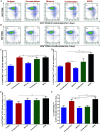Immune response effects of diverse vaccine antigen attachment ways based on the self-made nanoemulsion adjuvant in systemic MRSA infection
- PMID: 35540467
- PMCID: PMC9078882
- DOI: 10.1039/c8ra00154e
Immune response effects of diverse vaccine antigen attachment ways based on the self-made nanoemulsion adjuvant in systemic MRSA infection
Abstract
Nanoemulsion adjuvants-based vaccines have potent induced immune responses against methicillin-resistant Staphylococcus aureus (MRSA) infection. However, the efficacies and immune responses of different antigen-attaching ways on self-made nanoemulsion adjuvants remain unknown. In this study, we designed three formulations of nanoemulsion adjuvants (encapsulation, mixture, and combination) to explore their immune response-enhancing effects and their underlying mechanism in a systemic infection model of MRSA. Our results showed that the three nanoemulsion-attachment ways formulated with a fusion antigen of MRSA (HlaH35LIsdB348-465) all improved humoral and cellular immune responses. When compared with the mixture and combination formulations, the nanoemulsion-encapsulation group effectively promoted the antigen uptake of dendritic cells (DCs) in vitro, the activation of DC in draining lymph nodes and the delayed release of antigen at injection sites in vivo. Moreover, the encapsulation group induced a more ideal protective efficacy in a MRSA sepsis model by inducing more potent antibody responses and a Th1/Th17 biased CD4+ T cell response when compared with the other two attachment ways. Our findings suggested that the encapsulated formulation of vaccine with nanoemulsion adjuvant is an effective attachment way to provide protective immunity against MRSA infection.
This journal is © The Royal Society of Chemistry.
Conflict of interest statement
There are no conflicts of interest associated with the present work.
Figures







Similar articles
-
An immunopotentiator, ophiopogonin D, encapsulated in a nanoemulsion as a robust adjuvant to improve vaccine efficacy.Acta Biomater. 2018 Sep 1;77:255-267. doi: 10.1016/j.actbio.2018.07.034. Epub 2018 Jul 19. Acta Biomater. 2018. PMID: 30031164
-
Induction of systemic and mucosal immunity against methicillin-resistant Staphylococcus aureus infection by a novel nanoemulsion adjuvant vaccine.Int J Nanomedicine. 2015 Dec 3;10:7275-90. doi: 10.2147/IJN.S91529. eCollection 2015. Int J Nanomedicine. 2015. PMID: 26664118 Free PMC article.
-
Evaluating the Immune Response of a Nanoemulsion Adjuvant Vaccine Against Methicillin-Resistant Staphylococcus aureus (MRSA) Infection.J Vis Exp. 2023 Sep 1;(199). doi: 10.3791/65152. J Vis Exp. 2023. PMID: 37677037
-
Effects of immunomodulators on the response induced by vaccines against autoimmune diseases.Autoimmunity. 2017 Nov;50(7):393-402. doi: 10.1080/08916934.2017.1373766. Epub 2017 Sep 14. Autoimmunity. 2017. PMID: 28906131 Review.
-
ADP-ribosylating bacterial enzymes for the targeted control of mucosal tolerance and immunity.Ann N Y Acad Sci. 2004 Dec;1029:193-208. doi: 10.1196/annals.1309.036. Ann N Y Acad Sci. 2004. PMID: 15681758 Review.
Cited by
-
Novel approaches for the treatment of methicillin-resistant Staphylococcus aureus: Using nanoparticles to overcome multidrug resistance.Drug Discov Today. 2021 Jan;26(1):31-43. doi: 10.1016/j.drudis.2020.10.011. Epub 2020 Oct 20. Drug Discov Today. 2021. PMID: 33091564 Free PMC article. Review.
-
Epitope-loaded nanoemulsion delivery system with ability of extending antigen release elicits potent Th1 response for intranasal vaccine against Helicobacter pylori.J Nanobiotechnology. 2019 Jan 19;17(1):6. doi: 10.1186/s12951-019-0441-y. J Nanobiotechnology. 2019. PMID: 30660182 Free PMC article.
References
LinkOut - more resources
Full Text Sources
Research Materials

